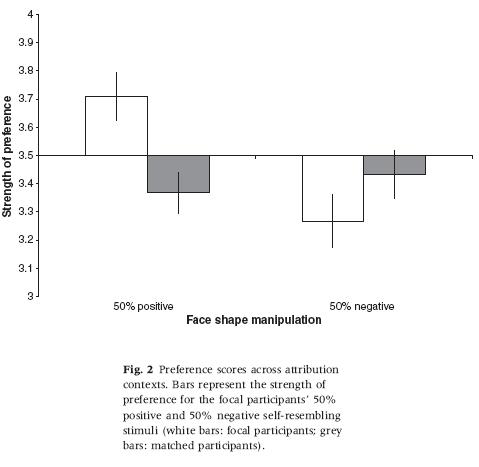if you want to be un-altruistic toward some un-kin of yours, it might be useful if you could spot who they are.
here’s some neat research [pdf] suggesting that perhaps we can do just that (further research is required, of course). this is one of those manipulated photographs studies — you know — where they take photos and alter them to look more or less like the subjects. note that the study was done on w.e.i.r.d. students — and way more females (n=112) than males (n=32):
“Kin recognition: evidence that humans can perceive both positive and negative relatedness” (2012)
“… The evolution of spite would have been greatly facilitated by the ability to recognize negative relatives (West & Gardner, 2010). The current study is the first to find such an ability among humans, one of only a handful of species (Keller & Ross, 1998; Giron & Strand, 2004) for which there is evidence of negative relatedness recognition, by introducing a novel cue to negative relatedness (negative self-resemblance). Specifically, we found opposing effects of positive and negative self-resemblance – cues to positive and negative relatedness, respectively – on trusting and attractiveness attributions, as predicted. This result provides a foothold for the possibility of the evolution of spiteful behaviour among humans. Future research should examine this possibility.
“Although the effects of positive and negative self resemblance in our study were generally small, our study was an experimental one. Thus, we controlled the strength of the manipulation. It was our intention to make the stimuli subtle, to ensure that the participants would not discover the nature of the manipulation. A subtle manipulation, however, will tend to lead to subtle effects. What we hoped to show was not that the positive and negative self-resemblance manipulations had large effects on preferences or behaviour in the context of a laboratory experiment, but that they had predictable effects at all, especially as these effects speak to theory (Prentice & Miller, 1992).
“Relative to matched participants, focal participants generally had positive preferences for their own positive self-resembling faces but negative preferences for their own negative self-resembling faces across contexts….“
here’s the relevant graphic:
“Spite is hypothesized to evolve under relatively restrictive conditions (West & Gardner, 2010), and so it is expected to be rare. However, two conditions may, together, favour its evolution: (1) ‘viscous’ breeding systems and (2) the ability to recognize negative relatives. Population viscosity can make competition increasingly local among individuals (Taylor, 1992a,b), and local competition encourages the evolution of spite (Gardner & West, 2004). Furthermore, individuals immigrating into a viscous population may be strongly negatively related to members of the indigenous population, because immigrants are highly unlikely to bear the same (relevant) alleles as indigenous individuals (Krupp et al., 2011).”
for “viscous breeding systems” i think we can safely insert “inbreeding” or “cousin marriage” or “consanguineous matings.” they are all certainly viscous.
“Negative relatedness recognition can improve the targeting of a spiteful action to increase indirect fitness benefits (by delivering harm specifically to negative relatives whilst sparing positive ones), and our results provide evidence that humans have the mechanisms in place to do precisely this. Moreover, countless animal species use phenotype matching to determine relatedness, and other kin recognition systems exist that might also be employed to discriminate against negative relatives (reviewed in Krupp et al., 2011). Further discoveries that organisms have the capacity to recognize negative relatives will lay a foundation for the study of spiteful behaviour, arguably the last great unexplored problem of social evolution….”
_____
what i’d like to see is some research done on actual inbred populations. maybe a comparison between a non-inbreeding population and an inbreeding one to see if either of the two groups is better at spotting their kin or un-kin.
for that matter, i wonder if kin in inbred populations actually look more like one another than kin in outbred populations (and, therefore, look more unlike non-kin). you would think they ought to since they share more of the same genes with one another. you’d think that’d affect appearance, too. remember the ghoul brothers from syria (click on picture for LARGER view)?:
redzengenoist said about them: “It really is striking how much they look like one another. Far more than I would expect the average family group to have similar appearance…. I’m thinking of selection for markedness of ingroup-ness. I can’t help but wonder if having a distinct ‘look’ helps to facilitate the evolutionary advantages of inbreeding….”
i noted: “and, like the big families i’ve known (from my slightly inbred area of the world), some of them look more like each other than they do to the others. the two (chubby guys, roundish faces) on the right and the guy all the way on the left look similar — those three look like mom? or dad? and the other five look more like each other — like the other parent (whichever one).”
maybe it’s easier to spot kin and non-kin in a “viscous” population. the more viscous the better, perhaps.
(note: comments do not require an email. play spot the relatives!)

